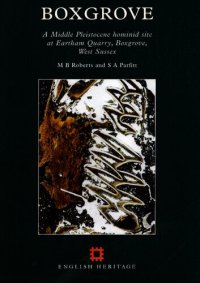
Ebook: Boxgrove: A Middle Pleistocene Hominid Site at Eartham Quarry, Boxgrove, West Sussex
Author: Mark B. Roberts Simon A. Parfitt
- Genre: History // Archaeology
- Series: English Heritage Archaeological Reports 17
- Year: 1999
- Publisher: English Heritage
- City: London
- Language: English
- pdf
With contributions by L. A. Austin, M. R. Bates, C. A. Bergman, D. Q. Bowen, D. R. Bridgland, J. A. Catt, C. R. Cartwright, S. N. Collcutt, A. David, G. Gard, P. Goldberg, R. Grun, R. Harland, C. J. O. Harrison, J. A. Holman, B. G. Irving, S. G. Lewis, P. Linford, R. I. Macphail, D. A. Parks, R. C. Preece, A. M. Rae, H. M. Rendell, E. J. Rhodes, C. L. Roberts, J. R. Stewart, C. B. Stringer, G. A. Sykes, E. Trinkaus, F. F. Wenban-Smith, J. E. Whittaker, and K. H. Wilhelmsen.
Ebook (PDF) published 2013.
Extensive palaeoenvironmental and palaeoanthropological evidence was recovered from two quarry sites at Boxgrove, West Sussex, in excavations 1983-92 and 1995-96 (funded by English Heritage). Results of analyses on the evidence recovered between 1983 and 1989 are reported here. Boxgrove is located 12km north of the English Channel within the upper part of the Sussex Coastal plain. It is the largest known area of in situ Lower Palaeolithic land surface in Europe. Pleistocene sediments resting on a marine platform at the foot of a chalk sea-cliff reveal the history of environmental change during a Middle Pleistocene temperate stage, which was followed by a period of falling sea-level and deteriorating climate. The extensive vertebrate fauna and other environmental evidence recovered, together with sediment analysis, has enabled these ancient environments to be reconstructed. A wide, open area in front of the cliff face underwent a succession from shore face, to freshwater marsh. Above the cliff were downlands of mixed forest, which became dominated by coniferous woodland and grassland by the interglacial to glacial transition. A tibia of 'Homo cf heidelbergensis', recovered in 1993, has proven to be the oldest hominid fossil yet found in Britain. This tibia, two teeth of the same species found in 1995, the mammalian fauna, and a wealth of stone tools made from local flint recovered on undisturbed surfaces, have enabled the authors to reconstruct discrete episodes of activity, including on-site tool making and butchering. Flint handaxes were used to butcher the carcasses of deer, bison and rhinoceros. The chronological position of the temperate sediments has been determined by mammalian biostatigraphy to an interglacial at the end of the 'Cromerian Complex', approximately 500 kyt bp.
Ebook (PDF) published 2013.
Extensive palaeoenvironmental and palaeoanthropological evidence was recovered from two quarry sites at Boxgrove, West Sussex, in excavations 1983-92 and 1995-96 (funded by English Heritage). Results of analyses on the evidence recovered between 1983 and 1989 are reported here. Boxgrove is located 12km north of the English Channel within the upper part of the Sussex Coastal plain. It is the largest known area of in situ Lower Palaeolithic land surface in Europe. Pleistocene sediments resting on a marine platform at the foot of a chalk sea-cliff reveal the history of environmental change during a Middle Pleistocene temperate stage, which was followed by a period of falling sea-level and deteriorating climate. The extensive vertebrate fauna and other environmental evidence recovered, together with sediment analysis, has enabled these ancient environments to be reconstructed. A wide, open area in front of the cliff face underwent a succession from shore face, to freshwater marsh. Above the cliff were downlands of mixed forest, which became dominated by coniferous woodland and grassland by the interglacial to glacial transition. A tibia of 'Homo cf heidelbergensis', recovered in 1993, has proven to be the oldest hominid fossil yet found in Britain. This tibia, two teeth of the same species found in 1995, the mammalian fauna, and a wealth of stone tools made from local flint recovered on undisturbed surfaces, have enabled the authors to reconstruct discrete episodes of activity, including on-site tool making and butchering. Flint handaxes were used to butcher the carcasses of deer, bison and rhinoceros. The chronological position of the temperate sediments has been determined by mammalian biostatigraphy to an interglacial at the end of the 'Cromerian Complex', approximately 500 kyt bp.
Download the book Boxgrove: A Middle Pleistocene Hominid Site at Eartham Quarry, Boxgrove, West Sussex for free or read online
Continue reading on any device:

Last viewed books
Related books
{related-news}
Comments (0)